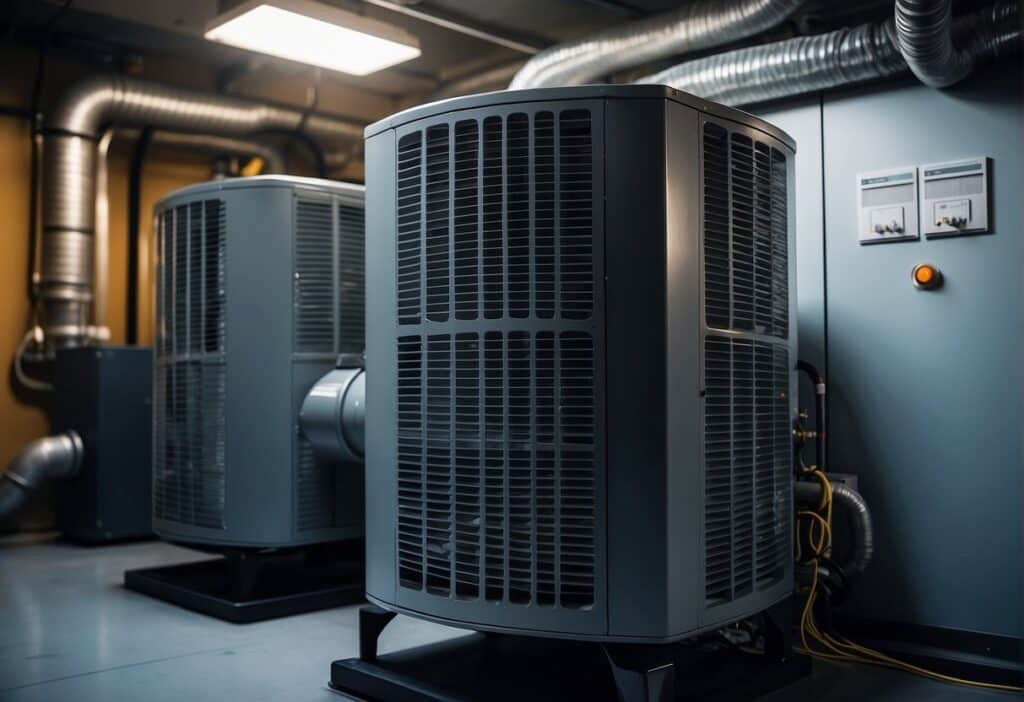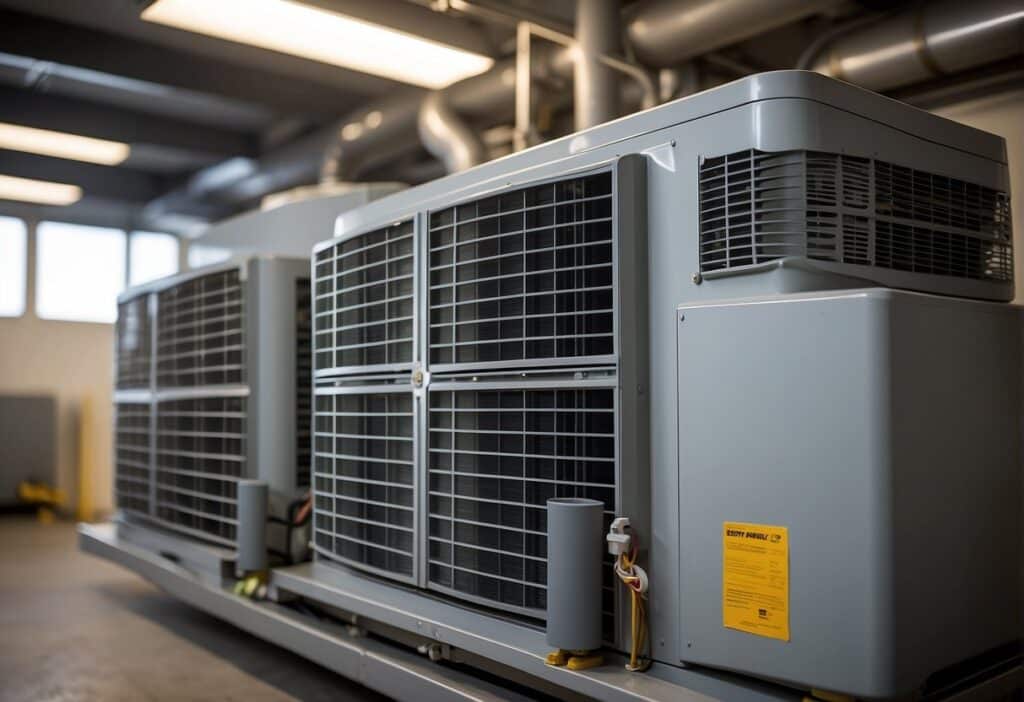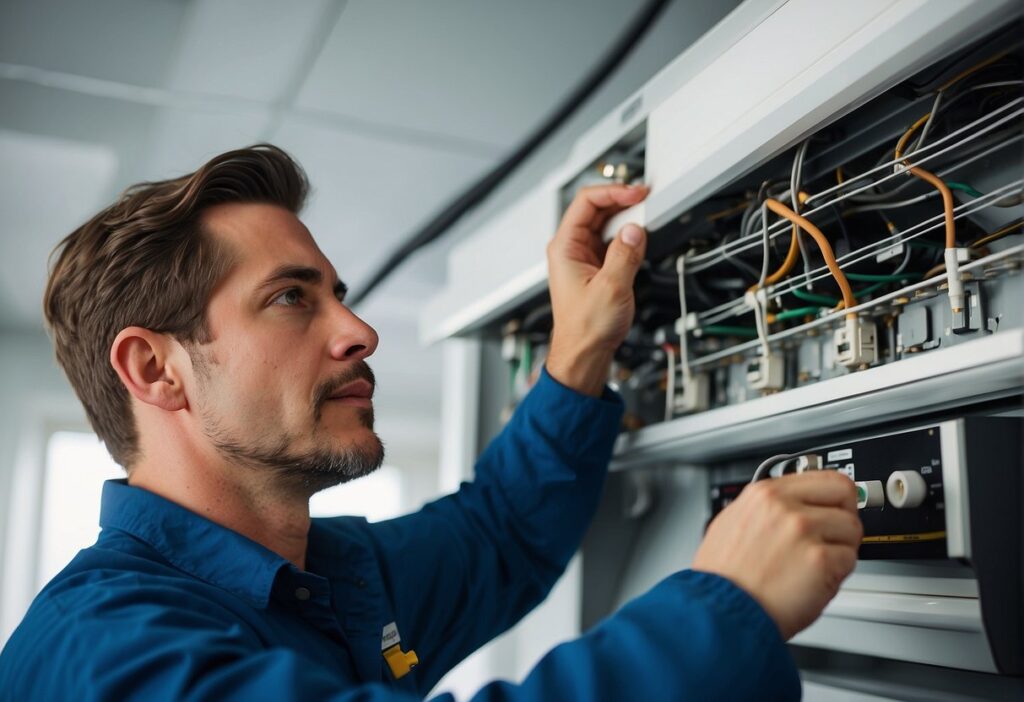Central and Ductless HVAC Systems
As we dive into the details of HVAC systems, it’s important to comprehend how central and ductless systems operate, their individual merits, and the distinctions that set them apart.

Understanding Central HVAC Systems
Central HVAC systems are the most commonly installed systems in United States homes. They consist of a central air conditioner that cools and heats the air, a series of ductwork that distributes that air throughout the home, and a thermostat for control. Central systems excel in uniform heating and cooling across multiple rooms, making them efficient for larger spaces where a consistent indoor environment is desired.
- Heating and Cooling Distribution: Evenly throughout the home via ducts.
- Thermostat Control: Centralized, often with options for zoning.
- System Type: Typically split into outdoor (condenser/compressor) and indoor (evaporator/air handler) units.
Exploring the Advantages of Ductless HVAC Systems
Ductless mini-split systems are an efficient and flexible alternative to traditional centralized systems. They require no ductwork, reducing energy losses and making them ideal for additions to homes, retrofitting in houses without ducts, or targeting individual rooms.
- No Ductwork Required: Avoids energy losses associated with ducts.
- Customized Comfort: Individual thermostats for personalized temperature settings in each room.
- Installation: Less invasive and often quicker than installing ductwork.
Comparing Central Air Conditioning and Ductless Options
When we compare central air conditioners with ductless systems, several factors come into play. Central air conditioning is well-suited for cooling multiple rooms, but it can lead to substantial energy loss through leaky ductwork. On the other hand, a ductless mini-split system offers direct cooling and heating without those losses, boasting increased energy efficiency especially in homes without existing ductwork or in home additions where extending ducts would be impractical.
- Energy Efficiency: Ductless systems generally provide better efficiency due to the absence of duct-related losses.
- Aesthetic Impact: Central systems are less visible inside the home, while ductless systems require wall-mounted units in each room.
- Cost: Initial setup for ductless systems may be higher per zone, but long-term savings can offset this.
Heat Pump and Furnace Fundamentals
In this section, we explore the essential principles of two key heating systems: heat pumps and furnaces. We’ll examine how each system operates, the types available, and compare their heating mechanisms.
Heat Pump Systems: An Overview
Heat pumps are versatile, energy-efficient options for both heating and cooling homes. They function by transferring heat from one location to another using a refrigeration cycle, similar to air conditioners, but with the added capability to reverse the process for heating. Electric heat pumps are the most common, but some systems also draw energy from natural sources like geothermal heat.
Types of Heat Pumps
- Air source
- Ground source (geothermal)
- Water source
Understanding the Different Types of Furnaces
Furnaces generate heat by burning fuel, and they’re a vital component in many heating systems. The three main types of furnaces are gas, oil, and electric. Gas furnaces, which use natural gas, are prevalent due to their cost-effectiveness and efficiency. Oil furnaces are less common but are still used in areas where natural gas isn’t readily available. Electric furnaces, while often more expensive to operate, offer a clean and safe alternative.
Furnace Fuel Sources
- Natural Gas
- Oil
- Electricity
Analyzing Heat Pump Versus Furnace Heating
When comparing heat pumps and furnaces, it’s crucial to consider the climate and heating needs. Heat pumps are more energy-efficient since they move heat rather than generate it, making them particularly cost-effective in moderate climates.
Furnaces, especially when powered by natural gas, tend to provide more powerful heating in colder environments. We often recommend electric heat pumps in areas with milder winters and gas furnaces in regions that experience harsh, cold temperatures.
Advanced HVAC System Types
As we explore advanced HVAC system types, it’s important to understand that these systems often offer higher efficiency, better environmental performance, and innovative technology that can accommodate a range of specific needs. We’ll focus on systems known for their advanced features, such as geothermal HVAC systems that utilize earth’s temperatures, and hybrid systems that combine multiple energy sources.

Unraveling the Mystery of Geothermal HVAC Systems
Geothermal HVAC systems take advantage of the constant temperature beneath the Earth’s surface to provide heating and cooling. Using a series of pipes called a loop system, these geothermal heat pumps move heat into and out of a building. Notably, geothermal systems greatly improve air quality and are known for their quiet operation and longevity.
Hybrid HVAC Systems: Best of Both Worlds
The innovation behind hybrid HVAC systems combines the energy efficiency of heat pumps with the power of traditional furnaces. Hybrid split systems allow us to select the most economical fuel source for the conditions, which can result in lower utility bills and reduced environmental impact.
Packaged HVAC Systems: A Comprehensive Guide
A packaged HVAC system incorporates multiple components like the compressor, condenser, and evaporator into a single outdoor unit. These systems, often installed on rooftops or in compact spaces, simplify installation and maintenance. They are particularly well-suited for small to medium-sized buildings where space is at a premium.
Split HVAC Systems: Advantages and Applications
Split systems are the most commonly installed HVAC systems and consist of an outdoor unit containing the compressor and condenser, and one or more indoor units containing the air handler. Their main advantage is their ability to provide targeted heating or cooling to specific areas of a building, making them both versatile and energy-efficient.
Variable Refrigerant Flow (VRF) Systems: Efficiency and Flexibility
Variable Refrigerant Flow (VRF) systems can heat and cool different zones simultaneously, offering significant improvements in energy efficiency and occupant comfort. They are particularly adept at adjusting to the varying needs of different areas, ensuring we have a ventilation system that maintains consistent air quality across various spaces.
Maintenance, Efficiency, and Air Quality
We recognize that regular maintenance, energy efficiency, and good indoor air quality are crucial for an HVAC system’s performance. Let’s explore how to keep systems running optimally, the importance of choosing high-efficiency units, and the significance of maintaining excellent air quality indoors.
Maintenance Tips for Keeping Your HVAC System Optimal
Routine Checks
Perform biannual maintenance checks to keep your air conditioner in peak condition. This includes inspecting and cleaning components such as coils and filters.
- Filters: Replace or clean HVAC filters every 30 to 90 days, depending on usage and type, to ensure proper airflow and prevent dirt accumulation.
- Ventilation: Maintain and clean the ventilation system to avoid obstructions that can lead to inefficient operation and poor air quality.
Professional Servicing
Have a certified technician service your HVAC system annually to diagnose and rectify any underlying issues before they escalate.
Choosing High-Efficiency Systems for Energy and Cost Savings
Energy Star Ratings
Opt for HVAC systems with high Energy Star ratings to reduce energy consumption and installation costs in the long term.
- Smart Thermostats: Install smart thermostats for better control over heating and cooling, adapting to climate conditions and reducing electricity bills.
- Weather-Resistant Features: Select systems with enhancements to handle extreme weather conditions, minimizing the energy drain during peak seasons.
Initial Costs vs. Long-Term Savings
While high-efficiency systems may come with higher upfront costs, they lead to significant savings on energy bills over time.
Understanding the Significance of Indoor Air Quality
Ventilation Upgrades
Ensure your HVAC system includes quality ventilation mechanisms to help mitigate pollutants and maintain a fresh air supply.
Air Quality Products
Consider integrating additional air quality products like air purifiers and humidifiers for an extra layer of air quality control.
Regular Monitoring
Use air quality monitors to keep track of the air cleanliness in your home, adjusting your HVAC operations to address any concerns promptly.
Maintaining the balance between maintenance, efficiency, and indoor air quality is not only beneficial for our health but also for our wallets and the environment. By following these practices, we can enjoy a comfortable atmosphere in our homes and workplaces.
Air Conditioning Check-Ups and Troubleshooting
Air conditioning systems require periodic check-ups to maintain optimal performance and troubleshoot issues before they turn into costly repairs. By understanding the components and processes, we can ensure our systems operate efficiently.

Importance of Regular Air Conditioning Check-Ups
Regular air conditioning check-ups are crucial for maintaining the system’s efficiency and longevity. By scheduling these assessments, we help ensure that our air conditioner operates at peak performance, which can reduce our energy bills and prevent unexpected breakdowns.
Key Components Checked During Air Conditioning Check-Up
During a check-up, several key components of the air conditioning system are inspected:
- Compressor: Ensures that the refrigerant is pumped effectively.
- Evaporator Coil: Checked for proper absorption of heat from the air.
- Condenser: Inspected for heat transfer efficiency.
- Refrigerant Levels: Verified to maintain optimal cooling cycles.
- Air Handler/Blower: Assures consistent air movement throughout the system.
- Air Ducts: Examined for leaks, blockages, and buildup of dust or debris.
Troubleshooting Common Air Conditioning Issues
When troubleshooting air conditioning problems, we look for common issues such as:
- Inadequate cooling, which could be due to low refrigerant levels or a malfunctioning compressor.
- Irregular cycles or short cycling, potentially caused by a dirty evaporator coil or faulty blower.
- Unusual noises from the unit, signifying potential mechanical issues or obstructions.
Professional vs. DIY Air Conditioning Check-Ups
Professional check-ups are thorough and can diagnose issues we might overlook. Self-conducted check-ups, while beneficial for minor issues and regular maintenance, might not cover complex system diagnostics. A professional technician’s expertise is invaluable for comprehensive assessment and troubleshooting.
Steps Involved in a Comprehensive Air Conditioning Check-Up
A comprehensive air conditioning check-up includes several steps:
- Inspecting the thermostat: To ensure it communicates correctly with the air conditioner.
- Checking the air filter: Replacing if necessary to maintain air quality and flow.
- Evaluating the electrical components: To confirm all connections are secure.
- Cleaning the air handler and condenser coils: To prevent obstructions and improve efficiency.
- Checking the system’s SEER rating: To gauge the air conditioner’s efficiency.
By adhering to these maintenance and troubleshooting practices, we help guarantee that our air conditioning systems function effectively and provide comfort throughout the seasons.
Frequently Asked Questions
What are the primary differences between central and ductless HVAC systems?
Central HVAC systems distribute conditioned air throughout a space using a network of ducts, making them suitable for cooling or heating multiple rooms simultaneously. On the other hand, ductless HVAC systems, also known as mini-split systems, allow for individual room temperature control without requiring ductwork, leading to potentially higher energy efficiency and less heat loss.
How does a heat pump system function compared to traditional HVAC systems?
A heat pump system uses refrigerant and electricity to transfer heat from inside to outside a home for cooling and vice versa for heating. This contrasts traditional systems that generate heat directly for warming or use compressors and refrigerants primarily for cooling.
In what ways do geothermal HVAC systems differ from conventional heating and cooling solutions?
Geothermal HVAC systems leverage the stable temperature of the earth to heat and cool homes efficiently. They use a series of underground pipes to exchange heat with the ground, which differs from conventional systems that rely on outdoor air temperature, leading to greater efficiency and lower operational costs.
What factors contribute to indoor air quality within HVAC systems?
Indoor air quality within HVAC systems is influenced by proper ventilation, filtration, and humidity levels. Regular maintenance of HVAC components, such as replacing filters and cleaning ducts, is crucial to minimizing pollutants and ensuring optimal air quality.
What are the advantages and potential drawbacks of hybrid HVAC systems?
Hybrid HVAC systems combine the energy efficiency of a heat pump with the power of a gas furnace to provide a versatile heating solution. While they can offer cost savings and adaptability to varying temperatures, they may come with a higher initial investment and require proper size and installation to work efficiently.
What considerations are important when selecting the appropriate size furnace for a home?
When choosing a furnace size for a home, it is essential to consider the home’s square footage, climate, insulation quality, expected heat loss, and the desired temperature. An accurately sized furnace ensures efficient operation, optimal comfort, and longevity of the heating system.

